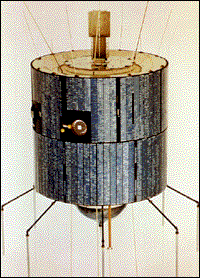The Applications Technology Satellites (ATS) were a series of experimental satellites launched by NASA, under the supervision of, among others, Wernher von Braun. The program was launched in 1966 to test the feasibility of placing a satellite into geosynchronous orbit.[1] The satellites were primarily designed to act as communication satellites, but also carried equipment related to meteorology and navigation. ATS-6 was the world's first educational satellite as well as world's first experimental Direct Broadcast Satellite (DBS) as part of the Satellite Instructional Television Experiment (SITE) between NASA and ISRO.[2]

Summary of Missions
| Mission | Launch Date | Duration | Major investigations | Notable mission highlights |
|---|---|---|---|---|
| ATS-1 | December 7, 1966 | 18 years | Spin stabilization, investigated the geostationary environment, space communications | First full-Earth cloud cover images[3] |
| ATS-2 | April 6, 1967 | 6 months | None | Launch vehicle failure caused spacecraft to reach undesirable orbit. Limited data was obtained.[4] |
| ATS-3 | November 5, 1967 | At least 20 years | Spin stabilization, communications tests | First color images from space.[5] ATS-3 was also used as a communications satellite, providing links to Antarctica and the Pacific Basin |
| ATS-4 | August 10, 1968 | 2 months in low orbit, failed to reach geostationary orbit, full mission did not occur | Intended (failed) objective of inserting a gravity-gradient-stabilized spacecraft into a geosynchronous orbit | Intended for geostationary orbit. Launch vehicle failure left it in a near useless LEO orbit.[6] Little data was obtained.[7] |
| ATS-5 | August 12, 1969 | 3 year design life | Communications tests, intended (failed) testing of an ion engine | Spacecraft entered an unintended spin and encountered excessive acceleration. This caused damage to the ion engine.[8] |
| ATS-6 | May 30, 1974 | 5 years | Tested several communications technologies, satellite assisted search and rescue, and broadcast television.[9] | First satellite to broadcast educational content.[10] |
See also
References
External links
Wikiwand in your browser!
Seamless Wikipedia browsing. On steroids.
Every time you click a link to Wikipedia, Wiktionary or Wikiquote in your browser's search results, it will show the modern Wikiwand interface.
Wikiwand extension is a five stars, simple, with minimum permission required to keep your browsing private, safe and transparent.
